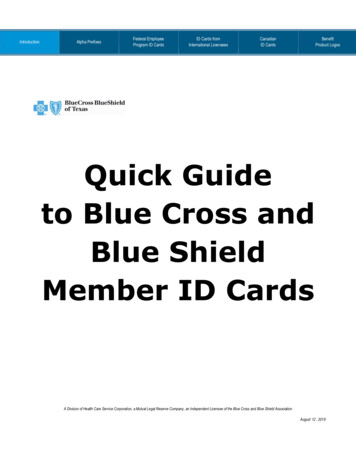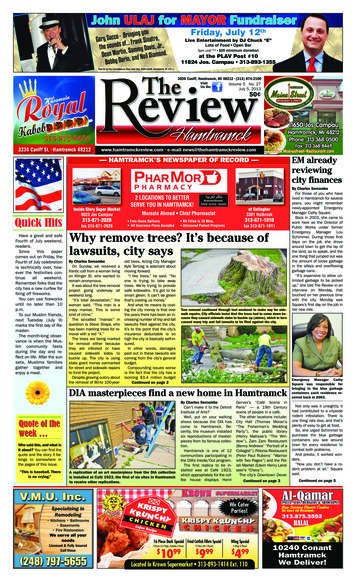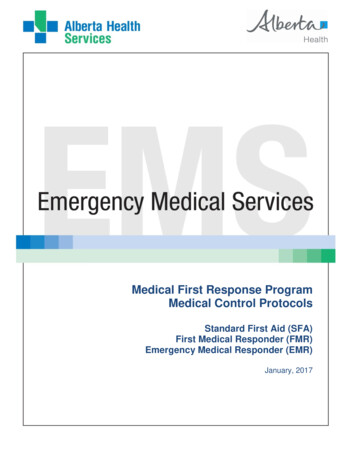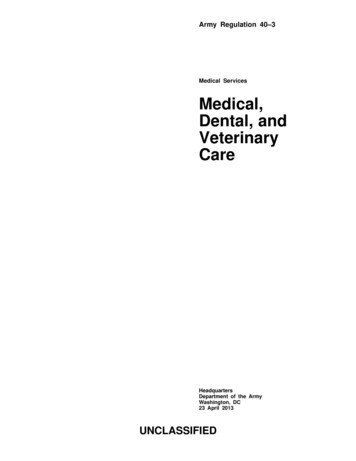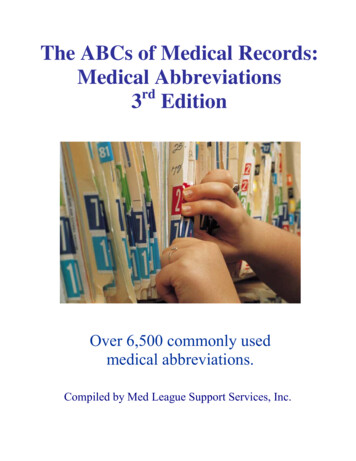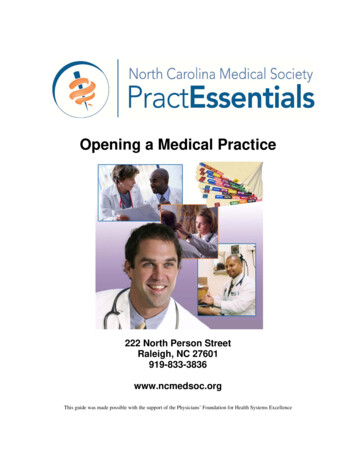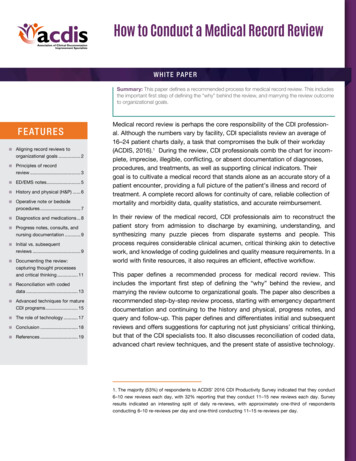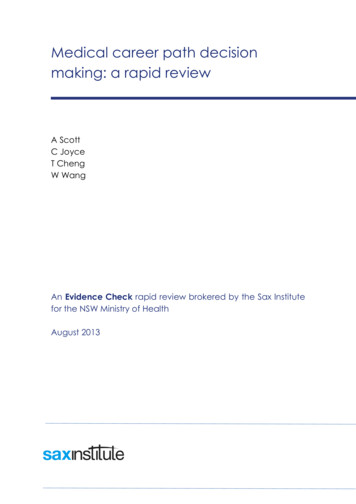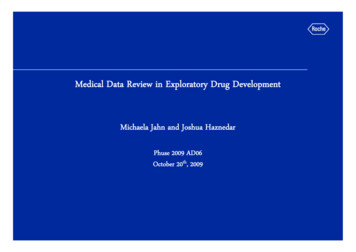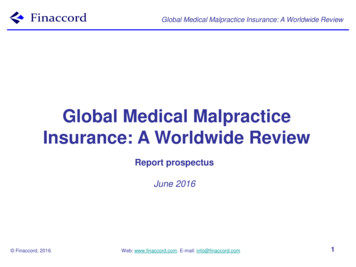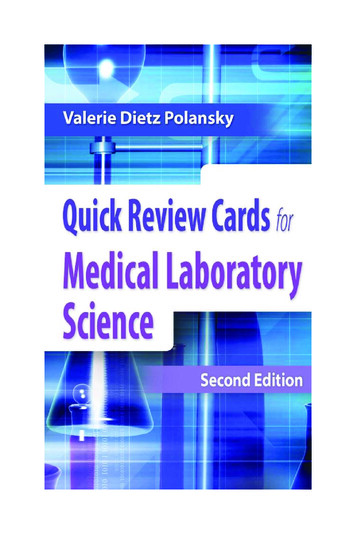
Transcription
2956 FM i-xxii 29/01/14 11:54 AM Page iQuick Review Cards for MedicalLaboratory Science Second EditionValerie Dietz Polansky, MEd,MLS(ASCP)CMProgram DirectorMedical Laboratory Technology ProgramSt. Petersburg CollegeSt. Petersburg, Florida
2956 FM i-xxii 29/01/14 11:54 AM Page iiF. A. Davis Company1915 Arch StreetPhiladelphia, PA 19103www.fadavis.comCopyright 2014 by F. A. Davis CompanyCopyright 2014 by F. A. Davis Company. All rights reserved. This product is protected by copyright. No part of it may be reproduced, stored ina retrieval system, or transmitted in any form or by any means, electronic, mechanical, photocopying, recording, or otherwise, without writtenpermission from the publisher.Printed in the United States of AmericaLast digit indicates print number: 10 9 8 7 6 5 4 3 2 1Senior Acquisitions Editor: Christa FratantoroDevelopmental Editor: Angela NortonManager of Content Development: George LangDesign and Illustration Manager: Carolyn O’BrienAs new scientific information becomes available through basic and clinical research, recommended treatments and drug therapies undergo changes.The author(s) and publisher have done everything possible to make this book accurate, up to date, and in accord with accepted standards at the timeof publication. The author(s), editors, and publisher are not responsible for errors or omissions or for consequences from application of the book, andmake no warranty, expressed or implied, in regard to the contents of the book. Any practice described in this book should be applied by the reader inaccordance with professional standards of care used in regard to the unique circumstances that may apply in each situation. The reader is advisedalways to check product information (package inserts) for changes and new information regarding dose and contraindications before administeringany drug. Caution is especially urged when using new or infrequently ordered drugs.ISBN: 978-0-8036-2956-1Authorization to photocopy items for internal or personal use, or the internal or personal use of specific clients, is granted by F. A. Davis Company forusers registered with the Copyright Clearance Center (CCC) Transactional Reporting Service, provided that the fee of .25 per copy is paid directly toCCC, 222 Rosewood Drive, Danvers, MA 01923. For those organizations that have been granted a photocopy license by CCC, a separate system ofpayment has been arranged. The fee code for users of the Transactional Reporting Service is: 978080362956-1/14 0 .25.
2956 FM i-xxii 29/01/14 11:54 AM Page iiiDedicated to my husband, Gary, for his support andencouragement through another long project, and in lovingmemory of my parents, Bill and Lee Dietz, who provided mewith the education that was the foundation of my career.
2956 FM i-xxii 29/01/14 11:54 AM Page iv
2956 FM i-xxii 29/01/14 11:54 AM Page vPrefaceQuick Review Cards for Medical Laboratory Science weredeveloped as a study aid to improve student performanceon Board examinations in medical laboratory science(medical technology) at both the technician and technologist levels. (Technician candidates may skip the sectionon management and education.)This card deck is the product of more than 30 years ofexperience teaching hundreds of students who have successfully passed Board examinations at both levels. Thecard format allows for easy sorting and portability, makingthem ideal for quick reviews and last-minute studying. Useof these cards alone, however, does not guarantee a passing score; they are intended to be used as an adjunct totraditional textbooks. Students are encouraged to highlight unfamiliar information and to refer to textbooks andclass notes to supplement their study of those topics. Theuse of a multiple-choice review book and practice examsalso will help to round out a student’s preparation for theBoard exam.The review cards will also be beneficial to MSL and MLTstudents before graduation as they prepare for course examinations. Professionals who are cross-training or reenteringthe workplace will find these cards useful as well.vNo review of this type can include all topics. This reviewfocuses on common procedures and disorders, otherknowledge that entry-level laboratory professionals are expected to have, and topics that are frequently included onBoard exams. The review cards are written in an informalnote-taking style, using abbreviations, symbols, and shortphrases to maximize the amount of information included.A list of abbreviations is found in the frontmatter.New to the second edition are a chapter on moleculardiagnostics and graphics for select topics. Space did notallow for inclusion of drawings of all cells/organisms. Students are encouraged to refer to textbooks to supplementtheir review with additional pictures and diagrams. Furtherbenefit could be derived from making their own drawings,diagrams, and flow charts. Active and frequent review willlead to higher scores.Every effort was made to ensure the accuracy of thecontent. In some cases, discrepancies were found withinand among references; then information was either selected from the most recent publication or confirmed inanother source. Please let the publisher know if you havesuggestions for improving future editions.
2956 FM i-xxii 29/01/14 11:54 AM Page vi
2956 FM i-xxii 29/01/14 11:54 AM Page viiBibliographyArneson, W., & Brickell, J. ClinicalChemistry A Laboratory Perspective.Philadelphia, PA: F.A. Davis, 2007.Bishop, M. L., Fody, E. P., & Schoeff, L. E.Clinical Chemistry: Principles, Procedures,Correlations (6th ed.). Philadelphia, PA:Lippincott Williams & Wilkins, 2010.Bruns, D. E., Ashwood, E. R., & Burtis, C.A. Fundamentals of MolecularDiagnostics. St. Louis, MO: SaundersElsevier, 2007.Buckingham, L. & Flaws, M. L. MolecularDiagnostics Fundamentals, Methods,& Clinical Applications. Philadelphia,PA: F.A. Davis, 2007.Ciesla, B., Hematology in Practice(2nd ed.). Philadelphia: F.A. DavisCompany, 2012.Harmening, D. M., Clinical Hematology and Fundamentals of Hemostasis (5th ed.). Philadelphia, PA:F.A. Davis, 2009.viiHarmening, D. M., Laboratory Management Principles and Processes(2nd ed.). St. Petersburg, FL: D. H.Publishing & Consulting, 2007.Harmening, D. M., Modern Blood Bankingand Transfusion Practices (6th ed.).Philadelphia, PA: F. A. Davis, 2012.Kern, M. E. & Blevins, K. S. Medical Mycology, A Self-Instructional Text (2nd ed.).Philadelphia, PA: F.A. Davis, 1997.Kiser, K. M., Payne, W. C., & Taff, T. A.Clinical Laboratory Microbiology APractical Approach. Upper SaddleRiver, NJ: Pearson Education, 2011.Leventhal, R., & Cheadle, R.F. MedicalParasitology: A Self-Instructional Text(5th ed.). Philadelphia, PA: F.A. Davis,2002.Mahon, C. R., Lehman, D. C., &Manuselis, G. Textbook of DiagnosticMicrobiology (4th ed.). Philadelphia,PA: W B. Saunders, 2011.McKenzie, S. B., & Williams, J. L. ClinicalLaboratory Hematology. Upper SaddleRiver, NJ: Pearson Education, 2010.Mundt, L. A., & Shanahan, K. Graff’s Textbook of Urinalysis and Body Fluids(2nd ed.). Philadelphia, PA: LippincottWilliams & Wilkins, 2011.Quinley, E. D. ImmunohematologyPrinciples & Practice (3rd ed.).Philadelphia, PA: LippincottWilliams & Wilkins, 2011.Rodak, B. F., Fritsma, G. A., & Koehane, E.M. Hematology Clinical Principles andApplications (4th ed.). St. Louis, MO:Elsevier Saunders, 2012.Standards for Blood Banks and TransfusionServices (27th ed.). Bethesda: AmericanAssociation of Blood Banks, 2011.Stevens, C. D. Clinical Immunologyand Serology: A Laboratory Perspective (3rd ed.). Philadelphia, PA:F.A. Davis, 2010.continued.
2956 FM i-xxii 29/01/14 11:54 AM Page viiiBibliography continuedStrasinger, S. K., & Di Lorenzo, M. S.The Phlebotomy Textbook (3rd ed.).Philadelphia, PA: F.A. Davis, 2011.Strasinger, S. K., & Di Lorenzo, M. S.,Urinalysis and Body Fluids (5th ed.).Philadelphia, PA: F.A. Davis, 2008.Sunheimer, R. L., & Graves, L. ClinicalLaboratory Chemistry. Upper SaddleRiver, NJ: Pearson Education, 2011.viiiTechnical Manual (17th ed.). Bethesda:American Association of BloodBanks, 2011.Turgeon, M. L. Clinical HematologyTheory and Procedures (5th ed.).Philadelphia, PA: LippincottWilliams & Wilkins, 2012.Turgeon, M. L. Immunology &Serology in Laboratory Medicine(4th ed.). St. Louis, MO: MosbyElsevier, 2009.Turgeon, M. L. Linne & Ringsrud’sClinical Laboratory Science (5th ed.).St. Louis, MO: Mosby Elsevier, 2007.
2956 FM i-xxii 29/01/14 11:54 AM Page ixReviewersEileen Carreiro-Lewandowski, CLSProfessorUniversity of MassachusettsDartmouth, MassachusettsTerry Dunkel, MS, MT(ASCP)Program Director, Assistant ProfessorPresentation CollegeAberdeen, South DakotaKathleen Engelmann, PhD, MLS(ASCP)Associate ProfessorUniversity of BridgeportBridgeport, ConnecticutDavid M. Falleur, Med, MT(ASCP), CLSChair, Associate ProfessorSouthwest Texas State UniversitySan Marcos, TexasAbraham Furman, PhDAssociate ProfessorOregon Institute of TechnologyKlamath Falls, OregonMichelle L. Gagan, MSHS, MLS(ASCP)Education CoordinatorYork Technical CollegeRock Hill, South CarolinaixAndrea R. Hoffmann, MT(ASCP)CMInstructorDelgado Community CollegeNew Orleans, LouisianaStephen M. Johnson, MS, MT(ASCP)Program DirectorSaint Vincent Health Center,Erie, PennsylvaniaKathy Kenwright, MS, MT(ASCP)SI, MBAssociate ProfessorUniversity of Tennessee HealthScience CenterMemphis, TennesseeKristi Lew, BSc (MLS), MSc, MLT,MLS(ASCP)CMAssistant ProfessorUniversity of AlbertaEdmonton, Alberta, CanadaAmy M. McCarty, MA, BS(ASCP)Program DirectorWashington Hospital CenterWashington, DCSonja Nehr-Kanet, MS, MLS(ASCP)CMClinical Associate ProfessorIdaho State UniversityMeridian, IdahoMaura Pieretti, PhD, HCLDScientific DirectorBayCare LaboratoriesTampa, FloridaEllen F. Romani, MHSA, MLS(ASCP)CM,BB, DLMDepartment ChairSpartanburg Community CollegeSpartanburg, South CarolinaAnchalee D. Steele, MT(ASCP)Program DirectorSpencerian CollegeLexington, KentuckyAmy Sutton, BS, MT(ASCP)Laboratory SupervisorSchryver MedicalPhoenix, Arizona
2956 FM i-xxii 29/01/14 11:54 AM Page x
2956 FM i-xxii 29/01/14 11:54 AM Page xiContentsSection 1 Laboratory OperationsReview, 1Credentialing, 2Agencies That Issue Guidelines/Standards, 3Federal Regulatory Agencies, 4Federal Regulations, 5CLIA ‘88 Test Complexities, 6Bloodborne Pathogens Standard, 7Specimen Infectivity, 8Packaging of Biologics for Shipping, 9Hazard Communication Standard (HCS),10Occupational Exposures to HazardousChemicals in Laboratories Standard,11Hazard Categories of Chemicals, 12Hazard Identification System, 14Storage of Chemicals, 16Fire Safety, 17Commonly Used Anticoagulants/Additives, 18Recommended Order for DrawingEvacuated Tubes & Filling Tubes Froma Syringe, 19xiRecommended Order for FillingMicrocollection Tubes from CapillaryPunctures, 20Special Situations in Phlebotomy, 21Special Test Requirements, 22Phlebotomy Sources of Error, 23Guidelines for Specimen Handling &Processing, 25Centrifuges, 26Examples of Criteria for SpecimenRejection, 27Types of Glass, 28Types of Plastic, 29Glassware Inscriptions, 30Volumetric Glassware, 31Glass Pipets, 32Mechanical Micropipets, 33Grades of Chemicals, 34Purified Water, 35CAP Reagent Labeling Requirements,36Brightfield Microscopy, 37Other Types of Microscopy, 39Informatics, 41Computer Hardware, 42Computer Software, 43Information Systems, 44Computer Networks, 45Quality Assessment, 46Quality Control, 47Quality Control Statistics, 48Interpretation of Quality Control Data,50Westgard Multirules, 53Typical Steps Taken When a ControlIs Outside Acceptable Range,54Calibration, 55Test Performance Specifications andVerification, 56Diagnostic Value of a Test, 58Other Components of a QAProgram, 59CLIA Requirements for ProcedureManuals, 61Ethical and Legal Issues, 62Commonly Used Prefixes in the MetricSystem, 64General Laboratory Calculations,65continued.
2956 FM i-xxii 29/01/14 11:54 AM Page xiiContents continuedSection 2 Clinical Chemistry Review, 67Comparison of Conventional andSI Units for Selected ReferenceRanges, 68Examples of Patient Variables That MayAffect Chemistry Values, 69Examples of Preanalytical FactorsThat May Affect ChemistryResults, 70Differences in Analyte Concentrations,72Photometric Methods, 73Visible Light, 75Wavelengths Used inSpectrophotometry, 76Chromatography, 77Other Analytic Techniques, 78Steps in Automated Analysis, 79Chemistry Panels, 80Carbohydrates, Lipids, andProteins, 81Regulation of Glucose, 83Diabetes Mellitus, 84xiiTests for Diabetes Mellitus, 85Typical Laboratory Findings inUncontrolled Diabetes Mellitus, 86Metabolic Syndrome, 87Aminoacidopathies, 88Protein Electrophoresis, 89Common Serum Protein ElectrophoresisPatterns, 90Nonprotein Nitrogen Compounds, 92Major Electrolytes, 93Other Electrolytes, 95Iron and Related Tests, 97Factors That Influence EnzymaticReactions, 98Enzymes of Clinical Significance, 99Summary of Diagnostic Enzymology, 101Cardiac Markers for Diagnosis of AcuteMyocardial Infarction, 102Other Cardiac Tests, 103Bilirubin Metabolism, 104Types of Bilirubin, 105Unconjugated versus ConjugatedBilirubin, 106Differential Diagnosis of Jaundice, 107Pituitary Hormones, 108Thyroid and Parathyroid Hormones, 110Thyroid Function Testing, 111Adrenal Hormones, 112Reproductive Hormones, 113Pancreatic Hormones, 114Therapeutic Drug Monitoring (TDM),115Therapeutic Drug Groups, 116Toxic Agents, 117Drugs of Abuse Urine Screen, 118Common Tumor Markers, 119Acid-Base Balance Terminology, 121Acid-Base Imbalances, 123Arterial Blood Gases Terminology, 124Blood Gas Parameters, 125Blood Gas Instrumentation, 126Sources of Error in Arterial Blood Gases,127Calculated Chemistry Values, 128Chemistry Calculations, 131continued.
2956 FM i-xxii 29/01/14 11:55 AM Page xiiiContents continuedSection 3 Clinical Microbiology Review, 135Biosafety Levels, 136CDC Classification of Biological Agents,137Biological Safety Cabinets, 138Sterilization and Disinfection, 139Bacterial Toxins, 141Specimen Collection Guidelines, 142Specimen Pre
Quick Review Cards for Medical Laboratory Science Second Edition Valerie Dietz Polansky, MEd, MLS(ASCP)CM Program Director Medical Laboratory Technology Program
